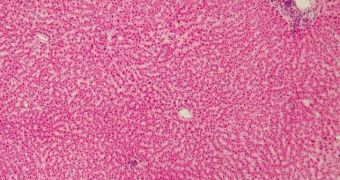Growing human liver cells on resorbable scaffolds made from materials similar to surgical sutures, has been a success, reports a new study carried out by German researchers.
They suggest that this kind of tissue could be used in place of donor organs during liver transplantation or until a suitable donor is available for patients suffering from acute liver failure.
The transplantation of liver cells – hepatocytes, represents a possible solution to the organ shortage problem, and besides, they have amazing regenerative properties.
So liver cell transplantation is a viable approach for patients with metabolic defects or fulminant hepatic failure, AlphaGalileo reports.
“Currently isolated liver cells are used for liver cell transplantation, but these cells suffer during cell isolation and cryopreservation, which is one reason there is limited success with this type of transplant procedure,” said Dr. Joerg-Matthias Pollok, Head of the Laboratory for Tissue Engineering and Cell Transplantation, Department of Hepatobiliary and Transplantation Surgery at the University Medical Center in Hamburg, Germany.
The tissue engineering approach allowed the researchers to create new liver tissue, and overcome the obstacles of liver cell transplantation.
They isolated liver cells from 12 human liver specimens with a viability of 82%, which after two days, formed tightly packed cellular aggregates (spheroids), and started to look much like a real liver.
Then, the human liver cells were distributed across a 3D porous structure of the polymer scaffolding, and from day two to day four, the average number of spheroids more than doubled, from 18 to 41 per visual field.
Dr. Pollok explained that this “experimental model represents a promising technique to culture human liver cells and prepare them for transplantation on a biodegradable polymer scaffold into the peritoneal cavity.
“Further studies are underway to confirm our results and may ultimately offer viable clinical options for liver cell transplantation in the future,” he added.
The latest statistics from the Organ Procurement and Transplantation Network, in January 2011, show that over 16,000 Americans are on the waiting list for a suitable liver.
This study will appear in the February issue of Liver Transplantation, a journal published by Wiley-Blackwell on behalf of the American Association for the Study of Liver Diseases.

 14 DAY TRIAL //
14 DAY TRIAL //